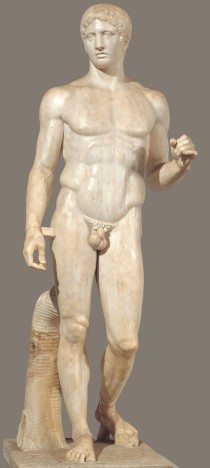
Joseph Watkins on a rhyton from Maresha
A helmeted female brandishes a shield in her left hand and a (now-lost) miniature spear in her right. She menaces whoever filled the drinking horn she adorned in 2nd-century BCE Maresha. From her array of armaments, she is clearly marked

Joseph Watkins on a rhyton from Maresha
A helmeted female brandishes a shield in her left hand and a (now-lost) miniature spear in her right. She menaces whoever filled the drinking horn she adorned in 2nd-century BCE Maresha. From her array of armaments, she is clearly marked

The Power of Architecture by Matthew Hinshaw
The 3rd century CE synagogue at Bar’am, in Israel’s Upper Galilee, and the late 20th century synagogue Temple Adath Yeshurun, in Syracuse New York, both utilize a foreign architectural language to assert legitimacy. The 50 by 66 meter Bar’am synagogue

The Power of Architecture by Matthew Hinshaw
The 3rd century CE synagogue at Bar’am, in Israel’s Upper Galilee, and the late 20th century synagogue Temple Adath Yeshurun, in Syracuse New York, both utilize a foreign architectural language to assert legitimacy. The 50 by 66 meter Bar’am synagogue

Gabriela Chartier on the Grave Stele of Hegeso
By the late fifth century B.C.E., the Kerameikos cemetery in Athens began to feature grave stelai depicting something new: snapshots of women in domestic scenes. An example is this grave stele inscribed “Hegeso, daughter of Proxenos,” which dates to around

Gabriela Chartier on the Grave Stele of Hegeso
By the late fifth century B.C.E., the Kerameikos cemetery in Athens began to feature grave stelai depicting something new: snapshots of women in domestic scenes. An example is this grave stele inscribed “Hegeso, daughter of Proxenos,” which dates to around

Brittany Bell on the Sounion kouros
The Sounion kouros is an 11 foot tall marble statue dating to c. 580 BCE. It was found in a sanctuary dedicated to Athena at Cape Sounion, Attica. The word kouros means “young man” in ancient Greek. Kouroi were

Brittany Bell on the Sounion kouros
The Sounion kouros is an 11 foot tall marble statue dating to c. 580 BCE. It was found in a sanctuary dedicated to Athena at Cape Sounion, Attica. The word kouros means “young man” in ancient Greek. Kouroi were

Carlos DeJesus on a grave stele in the Athens National Museum
A grave stele commemorated the life of an individual person. In Athens, many have been found in the area of the Dipylon, the city’s long-time cemetery. In the later fifth century BCE, the stelai depict people happy, in scenes of

Carlos DeJesus on a grave stele in the Athens National Museum
A grave stele commemorated the life of an individual person. In Athens, many have been found in the area of the Dipylon, the city’s long-time cemetery. In the later fifth century BCE, the stelai depict people happy, in scenes of

Shivani Mohan on the Suicide of Ajax
Around 540 BCE, Exekias illustrated the epic hero Ajax preparing to commit suicide on an Attic black figure amphora. Exekias focused on a single, poignant moment, one that inspires discussion to this day. Ajax prepares to impale himself on a

Shivani Mohan on the Suicide of Ajax
Around 540 BCE, Exekias illustrated the epic hero Ajax preparing to commit suicide on an Attic black figure amphora. Exekias focused on a single, poignant moment, one that inspires discussion to this day. Ajax prepares to impale himself on a

Julia Rosario on the east pediment of the Temple of Zeus at Olympia
The east pediment of the temple displays the chariot race between King Oinomaus and Pelops, the thirteenth suitor to strive for the hand of Hippodamia, the king’s daughter. Pelops had to race against Oinomaus whose chariot was drawn by immortal

Julia Rosario on the east pediment of the Temple of Zeus at Olympia
The east pediment of the temple displays the chariot race between King Oinomaus and Pelops, the thirteenth suitor to strive for the hand of Hippodamia, the king’s daughter. Pelops had to race against Oinomaus whose chariot was drawn by immortal

Adam Zahara on the Doryphoros
In Archaic Greece large stone sculptures named kouroi depicted idealized humans, a kind of mannequin of the perfect human figure. In the Classical era this practice did not die out, but the context and intent changed. One of the most

Adam Zahara on the Doryphoros
In Archaic Greece large stone sculptures named kouroi depicted idealized humans, a kind of mannequin of the perfect human figure. In the Classical era this practice did not die out, but the context and intent changed. One of the most

A Pilaster depicting Victory from Roman Ascalon, by Kiernan Acquisto
This marble pilaster is the best preserved of four from the late second-early third century CE basilica at Ascalon. The sculpture depicts a winged Victory standing barefoot on a globe supported by a kneeling Atlas. The victory’s right leg is

A Pilaster depicting Victory from Roman Ascalon, by Kiernan Acquisto
This marble pilaster is the best preserved of four from the late second-early third century CE basilica at Ascalon. The sculpture depicts a winged Victory standing barefoot on a globe supported by a kneeling Atlas. The victory’s right leg is

Megiddo in the Iron II period, by Danny Sarkis
These images derive from the site of Megiddo, a large administrative city in Israel’s Jezreel Valley, dating to the ninth and eighth centuries BCE. They help us understand what it meant to be an Israelite at this time. The building

Megiddo in the Iron II period, by Danny Sarkis
These images derive from the site of Megiddo, a large administrative city in Israel’s Jezreel Valley, dating to the ninth and eighth centuries BCE. They help us understand what it meant to be an Israelite at this time. The building